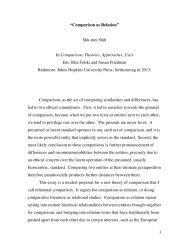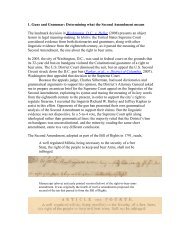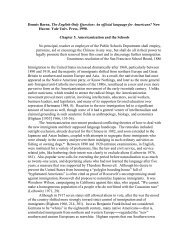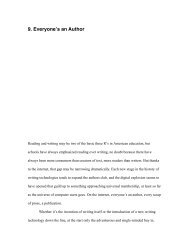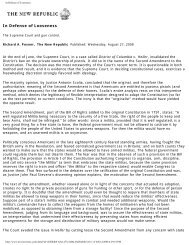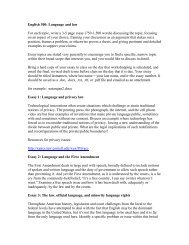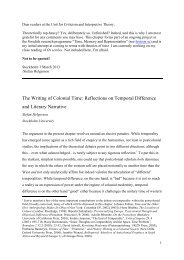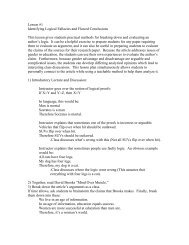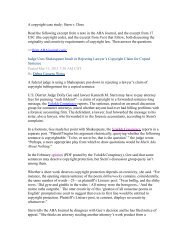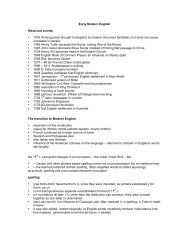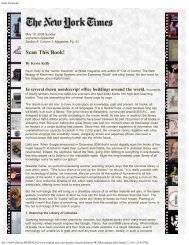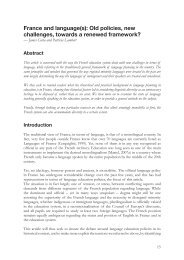Guns and Grammar: the Linguistics of the Second ... - English
Guns and Grammar: the Linguistics of the Second ... - English
Guns and Grammar: the Linguistics of the Second ... - English
You also want an ePaper? Increase the reach of your titles
YUMPU automatically turns print PDFs into web optimized ePapers that Google loves.
<strong>Guns</strong> <strong>and</strong> <strong>Grammar</strong>: <strong>the</strong> <strong>Linguistics</strong> <strong>of</strong> <strong>the</strong> <strong>Second</strong> Amendment<br />
Dennis Baron<br />
The <strong>Second</strong> Amendment to <strong>the</strong> U.S. Constitution reads,<br />
A well regulated Militia, being necessary to <strong>the</strong> security <strong>of</strong> a free State,<br />
<strong>the</strong> right <strong>of</strong> <strong>the</strong> people to keep <strong>and</strong> bear Arms, shall not be infringed.<br />
Manuscript <strong>and</strong> early printed versions <strong>of</strong> <strong>the</strong> amendment<br />
Originally <strong>the</strong> fourth <strong>of</strong> twelve constitutional amendments proposed in 1789, it was<br />
ratified by <strong>the</strong> states in 1791, along with <strong>the</strong> nine o<strong>the</strong>r amendments we call <strong>the</strong> Bill <strong>of</strong><br />
Rights.<br />
<strong>English</strong> common law had long acknowledged <strong>the</strong> importance <strong>of</strong> effective arms<br />
control, <strong>and</strong> <strong>the</strong> meaning <strong>of</strong> <strong>the</strong> <strong>Second</strong> Amendment seemed clear to <strong>the</strong> framers <strong>and</strong> <strong>the</strong>ir<br />
contemporaries: that <strong>the</strong> people have a right to possess arms when serving in <strong>the</strong> militia.<br />
Over <strong>the</strong> years, this “collective rights” interpretation <strong>of</strong> <strong>the</strong> <strong>Second</strong> Amendment was<br />
upheld in three Supreme Court decisions, in 1876, 1886, <strong>and</strong> most recently, in 1939<br />
(Bogus 2000). The meaning <strong>of</strong> <strong>the</strong> <strong>Second</strong> Amendment remained uncontroversial until<br />
1960, when a law review article using sources like American Rifleman asserted an<br />
additional, individual, right to bear arms for <strong>the</strong> purposes <strong>of</strong> self-defense (Hays 1960).<br />
Since that time, a growing bloc <strong>of</strong> constitutional scholars <strong>and</strong> historians has asserted that<br />
only <strong>the</strong> individual rights interpretation <strong>of</strong> <strong>the</strong> right to bear arms is correct, even calling<br />
this new reading <strong>the</strong> “st<strong>and</strong>ard model,” as if <strong>the</strong> original, collective rights interpretation<br />
hadn’t prevailed for more than a century (Bogus 2000b). And <strong>the</strong> majority <strong>of</strong> Americans<br />
now believe that <strong>the</strong> <strong>Second</strong> Amendment guarantees <strong>the</strong>ir right to tote a gun.<br />
Over <strong>the</strong> past twenty years, <strong>the</strong> individual rights model has been used to block<br />
passage <strong>of</strong> gun control laws, or to undercut <strong>the</strong>m – for example, <strong>the</strong> assault weapons ban<br />
<strong>of</strong> 1994 was allowed to expire ten years later because <strong>of</strong> pressure from gun-rights<br />
organizations.<br />
Despite <strong>the</strong> gun lobby’s insistence on a long common law tradition supporting <strong>the</strong><br />
individual’s right to weapons, gun regulation has been a feature <strong>of</strong> <strong>English</strong> law since <strong>the</strong>
Dennis Baron, <strong>Guns</strong> <strong>and</strong> <strong>Grammar</strong>, 2<br />
14 th century, when a series <strong>of</strong> Game Laws expressly restricted weapons ownership to<br />
members <strong>of</strong> <strong>the</strong> gentry who met thresholds <strong>of</strong> income <strong>and</strong> l<strong>and</strong> ownership – guns were for<br />
<strong>the</strong> wealthy, not <strong>the</strong> peasants or <strong>the</strong> lower middle class (Schwoerer 2000). Even <strong>the</strong><br />
<strong>English</strong> Bill <strong>of</strong> Rights, presented by <strong>the</strong> House <strong>of</strong> Commons to <strong>the</strong> new monarchs<br />
William <strong>and</strong> Mary in 1689, <strong>the</strong> very statute that is <strong>of</strong>ten cited by gun lobbyists as<br />
guaranteeing everyone’s right to own weapons, limited such ownership to Protestants,<br />
provided <strong>the</strong>y were <strong>of</strong> <strong>the</strong> right social class, <strong>and</strong> acknowledged <strong>the</strong> role <strong>of</strong> <strong>the</strong> law in<br />
fur<strong>the</strong>r regulating weapons: “that <strong>the</strong> subjects which are Protestants may have arms for<br />
<strong>the</strong>ir defence suitable to <strong>the</strong>ir conditions <strong>and</strong> as allowed by law” (<strong>English</strong> Bill 1689,<br />
emphasis added; Blackstone, whose opinions are frequently considered by <strong>the</strong> justices <strong>of</strong><br />
<strong>the</strong> U.S. Supreme Court, echoes this qualification <strong>of</strong> weapons ownership in his<br />
Commentaries).<br />
detail from <strong>the</strong> <strong>English</strong> Bill <strong>of</strong> Rights<br />
The British have continued <strong>the</strong>ir long tradition <strong>of</strong> relatively strict gun control, but<br />
in <strong>the</strong> United States resistance to gun regulation is on <strong>the</strong> increase. Most recently, in<br />
March, 2007, <strong>the</strong> U.S. Circuit Court <strong>of</strong> Appeals for <strong>the</strong> District <strong>of</strong> Columbia embraced<br />
<strong>the</strong> new individual rights model <strong>and</strong> ruled that Washington, D.C.’s, ban on h<strong>and</strong>guns, in<br />
effect since 1976, violated <strong>the</strong> <strong>Second</strong> Amendment’s guarantee <strong>of</strong> <strong>the</strong> right to keep <strong>and</strong><br />
bear arms (Parker v. District <strong>of</strong> Columbia 2007). As <strong>the</strong> court saw it, <strong>the</strong> <strong>Second</strong><br />
Amendment did not explicitly connect gun ownership with militia service. Writing <strong>the</strong><br />
majority opinion in <strong>the</strong> case, Judge Charles Silberman ruled that <strong>the</strong> first clause <strong>of</strong> <strong>the</strong><br />
<strong>Second</strong> Amendment, called <strong>the</strong> “militia clause,” was merely prefatory, a bit <strong>of</strong><br />
constitutional throat-clearing that had no bearing on <strong>the</strong> amendment’s “operative” second<br />
clause. And that operative clause prevented <strong>the</strong> city <strong>of</strong> Washington from banning<br />
h<strong>and</strong>guns.
Early printed version <strong>of</strong> <strong>the</strong> first two amendments<br />
Dennis Baron, <strong>Guns</strong> <strong>and</strong> <strong>Grammar</strong>, 3<br />
Washington, D.C., promptly appealed this decision to <strong>the</strong> U.S. Supreme Court,<br />
which granted certiorari <strong>and</strong> heard oral arguments in <strong>the</strong> case, renamed District <strong>of</strong><br />
Columbia v. Heller, on March 18 (07-290). The court will issue its decision by <strong>the</strong> end <strong>of</strong><br />
<strong>the</strong> current term, in June.<br />
In support <strong>of</strong> its appeal, <strong>the</strong> District solicited amicus briefs from groups<br />
supporting its position, including concerned historians, <strong>the</strong> American Academy <strong>of</strong><br />
Pediatrics, <strong>the</strong> Brady Center to Prevent Gun Violence, <strong>the</strong> City <strong>of</strong> Chicago, groups <strong>of</strong><br />
mayors, legislators, <strong>and</strong> district attorneys, <strong>the</strong> NAACP Legal Defense Fund, <strong>and</strong> <strong>the</strong><br />
American Bar Association.<br />
Because I had written an op ed essay in <strong>the</strong> Los Angeles Times questioning <strong>the</strong><br />
historicity <strong>of</strong> <strong>the</strong> Appeals Court’s interpretation (Baron 2007), <strong>the</strong> District’s attorney<br />
general asked me to prepare an amicus brief on <strong>the</strong> linguistics <strong>of</strong> <strong>the</strong> <strong>Second</strong> Amendment,<br />
explaining <strong>the</strong> amendment’s grammatical structure <strong>and</strong> tracing <strong>the</strong> meaning <strong>of</strong> its key<br />
words from <strong>the</strong> eighteenth century to <strong>the</strong> present. Toward <strong>the</strong> end <strong>of</strong> <strong>the</strong> process I finally<br />
managed to persuade two colleagues, Dick Bailey, <strong>of</strong> <strong>the</strong> Univ. <strong>of</strong> Michigan, <strong>and</strong> Jeff<br />
Kaplan, <strong>of</strong> San Diego State, to join me in <strong>the</strong> group which I <strong>the</strong>n renamed amici<br />
linguarum, <strong>the</strong> friends <strong>of</strong> language, as we refined <strong>and</strong> submitted <strong>the</strong> brief whose final<br />
version was actually drafted by our counsel, Charles Dyke, <strong>and</strong> titled “Brief for<br />
Pr<strong>of</strong>essors <strong>of</strong> <strong>Linguistics</strong> <strong>and</strong> <strong>English</strong>” (Baron et al 2008).<br />
Briefs for <strong>the</strong> gun rights side dismiss our claims as incorrect or overly-fussy<br />
grammar lessons. But from <strong>the</strong> questions <strong>and</strong> discussion during oral arguments in Heller,<br />
it was clear that at least Justice Souter had read our brief <strong>and</strong> found it convincing. This is<br />
certainly <strong>the</strong> closest I have managed to come, in my career, to using linguistic evidence to<br />
influence public policy.
The linguists’ amicus brief<br />
Dennis Baron, <strong>Guns</strong> <strong>and</strong> <strong>Grammar</strong>, 4<br />
Opponents <strong>of</strong> gun control have argued that <strong>the</strong>re are linguistic reasons for<br />
dismissing <strong>the</strong> first part <strong>of</strong> <strong>the</strong> <strong>Second</strong> Amendment as merely “prefatory” or<br />
“preambulatory,” even though18 th -century readers would never have seen it that way. In<br />
addition, <strong>the</strong>y reinterpret <strong>the</strong> meanings <strong>of</strong> <strong>the</strong> phrase bear arms <strong>and</strong> <strong>the</strong> word militia in<br />
ways that support <strong>the</strong>ir cause but go against <strong>the</strong> sense those words had in <strong>the</strong> federal<br />
period, <strong>and</strong> continue to have today. In support <strong>of</strong> <strong>the</strong> District <strong>of</strong> Columbia’s appeal to<br />
reverse that lower court ruling, we presented linguistic evidence arguing,<br />
1. that <strong>the</strong> <strong>Second</strong> Amendment was intended to be read in its entirety;<br />
2. that <strong>the</strong> first part <strong>of</strong> <strong>the</strong> amendment is both syntactically <strong>and</strong> semantically tied to<br />
<strong>the</strong> second;<br />
3. that <strong>the</strong> first part <strong>of</strong> <strong>the</strong> amendment specifies <strong>the</strong> reason for <strong>the</strong> second, that <strong>the</strong><br />
right to keep <strong>and</strong> bear arms is tied directly to <strong>the</strong> need for a well-regulated militia;<br />
4. that <strong>the</strong> ordinary <strong>and</strong> customary meaning <strong>of</strong> <strong>the</strong> phrase bear arms in <strong>the</strong> 18 th<br />
century is tied to military contexts, not to contexts involving hunting or self<br />
defense;<br />
5. <strong>and</strong> that <strong>the</strong> word militia refers in <strong>the</strong> federal period to an organized <strong>and</strong> trained<br />
body <strong>of</strong> citizen-soldiers, or to those eligible to serve in such a body, not to any<br />
<strong>and</strong> all Americans, most <strong>of</strong> whom were actually barred from militia service.
Syntax <strong>of</strong> <strong>the</strong> <strong>Second</strong> Amendment<br />
Dennis Baron, <strong>Guns</strong> <strong>and</strong> <strong>Grammar</strong>, 5<br />
Reading <strong>the</strong> <strong>Second</strong> Amendment as a statement in which every word counts follows from<br />
<strong>the</strong> opinion articulated by Chief Justice John Marshall: “It cannot be presumed that any<br />
clause in <strong>the</strong> constitution is intended to be without effect” (Marbury v. Madison, 1803).<br />
But even without that l<strong>and</strong>mark ruling, it would have been clear to 18 th -century readers<br />
that <strong>the</strong> first part <strong>of</strong> <strong>the</strong> <strong>Second</strong> Amendment was bound to <strong>the</strong> second part in a cause-<strong>and</strong>effect<br />
relationship, that <strong>the</strong> right to bear arms was tied by <strong>the</strong> framers directly to <strong>the</strong> need<br />
for a well-regulated militia.<br />
In his Appeals Court opinion, Judge Silberman pays particular attention to <strong>the</strong><br />
punctuation <strong>of</strong> <strong>the</strong> <strong>Second</strong> Amendment: “The provision’s second comma divides <strong>the</strong><br />
Amendment into two clauses; <strong>the</strong> first is prefatory, <strong>and</strong> <strong>the</strong> second operative” (Parker et<br />
al. v. District <strong>of</strong> Columbia 2007). While it is true that <strong>the</strong> second comma divides <strong>the</strong><br />
sentence syntactically, it is certainly not <strong>the</strong> case that such punctuation is necessarily used<br />
to divide <strong>the</strong> unimportant from <strong>the</strong> significant parts <strong>of</strong> a sentence, ei<strong>the</strong>r in <strong>the</strong> 18 th<br />
century or today.<br />
Because modern punctuation practice is well regulated, we as 21 st -century readers<br />
may be tempted to ascribe more to <strong>the</strong> <strong>Second</strong> Amendment’s punctuation than is<br />
warranted. Punctuation was not an important part <strong>of</strong> 18 th -century writing instruction. The<br />
most popular grammars in <strong>the</strong> framers’ day were written by Robert Lowth <strong>and</strong> Lindley<br />
Murray. Though both are concerned with correcting writing mistakes, <strong>and</strong> both give a<br />
number <strong>of</strong> rules for comma use, what Lowth tells us is not very encouraging to those who<br />
look to punctuation as an exact science: “The doctrine <strong>of</strong> punctuation must needs be very<br />
imperfect: few precise rules can be given, which will hold without exception in all cases;<br />
but much must be left to <strong>the</strong> judgment <strong>and</strong> taste <strong>of</strong> <strong>the</strong> writer” (Lowth 1762, 155).<br />
In addition to signaling syntactic breaks, eighteenth-century punctuation allowed<br />
for commas to be inserted as needed for breathing. Here is an example <strong>of</strong> such a pause,<br />
from Article III, section 1 <strong>of</strong> <strong>the</strong> U.S. Constitution: “The judicial power <strong>of</strong> <strong>the</strong> United<br />
States, shall be vested in one Supreme Court.”<br />
Article III <strong>of</strong> <strong>the</strong> Constitution<br />
The comma in that sentence does not separate prefatory material from substance.<br />
Instead, it marks a pause for breath. But times have changed. If a student put that comma<br />
in a paper today, it would be marked wrong.<br />
The Constitution has o<strong>the</strong>r punctuation practices we would also consider<br />
irregular. For example, in Art. I, sec. 10, <strong>the</strong> framers write <strong>the</strong> possessive it’s (modern<br />
practice would require its): “No state shall, without <strong>the</strong> consent <strong>of</strong> <strong>the</strong> Congress, lay any
Dennis Baron, <strong>Guns</strong> <strong>and</strong> <strong>Grammar</strong>, 6<br />
imposts or duties on imports or exports, except what may be absolutely necessary for<br />
executing it’s inspection laws” (emphasis added).<br />
Even 20 th -century constitutional amendments show irregular comma use. The 18 th<br />
Amendment contains commas, normally used today to set <strong>of</strong>f nonrestrictive clauses, to<br />
mark instead what must be read as a restrictive relative clause: “The right <strong>of</strong> citizens <strong>of</strong><br />
<strong>the</strong> United States, who are 18 years <strong>of</strong> age or older, to vote, shall not be denied or<br />
abridged by <strong>the</strong> United States or any state on account <strong>of</strong> age” (emphasis added). So does<br />
<strong>the</strong> even more recent 27 th Amendment (one <strong>of</strong> <strong>the</strong> original 12 amendments, but not<br />
ratified until 1992): “No law, varying <strong>the</strong> compensation for <strong>the</strong> services <strong>of</strong> <strong>the</strong> Senators<br />
<strong>and</strong> Representatives, shall take effect, until an election <strong>of</strong> Representatives shall have<br />
intervened” (emphasis added).<br />
While it is popularly held that <strong>the</strong> presence or absence <strong>of</strong> a comma can have a<br />
critical impact on <strong>the</strong> interpretation <strong>of</strong> a contract or a law, <strong>the</strong>se examples demonstrate<br />
that, even today, punctuation in such carefully-drafted documents as constitutions <strong>and</strong><br />
<strong>the</strong>ir amendments does not always reinforce meaning.<br />
But that’s not all. Apparently, some copies <strong>of</strong> <strong>the</strong> <strong>Second</strong> Amendment sent to<br />
some <strong>of</strong> <strong>the</strong> states for ratification had a different number <strong>of</strong> commas from <strong>the</strong> “<strong>of</strong>ficial”<br />
version as printed by <strong>the</strong> federal government (Van Alstyne 2007). Even <strong>the</strong> text <strong>of</strong> <strong>the</strong><br />
<strong>Second</strong> Amendment quoted in <strong>the</strong> Silberman decision contains only <strong>the</strong> first two<br />
commas, not <strong>the</strong> third. But that should not pose a problem, even for a strict<br />
constructionist. Punctuation only loosely correlated with meaning in <strong>the</strong> 18 th century, <strong>and</strong><br />
it would not be an exaggeration to claim that <strong>the</strong> <strong>Second</strong> Amendment would mean <strong>the</strong><br />
same thing – not just when it was written but today as well – whe<strong>the</strong>r it had one, two, or<br />
three commas, or none at all.<br />
Although Judge Silberman reads it o<strong>the</strong>rwise, <strong>the</strong> <strong>Second</strong> Amendment’s second<br />
comma tells us that <strong>the</strong> subsequent clause, “<strong>the</strong> right <strong>of</strong> <strong>the</strong> people to keep <strong>and</strong> bear Arms,<br />
shall not be infringed,” is <strong>the</strong> logical result <strong>of</strong> what preceded that comma, “A well<br />
regulated Militia, being necessary to <strong>the</strong> security <strong>of</strong> a free State.” That is because absolute<br />
phrases like <strong>the</strong> one at <strong>the</strong> start <strong>of</strong> <strong>the</strong> <strong>Second</strong> Amendment are commonly set <strong>of</strong>f by<br />
commas <strong>and</strong> signal a cause-<strong>and</strong>-effect logical relationship.<br />
Judge Silberman doesn’t call <strong>the</strong> “prefatory” phrase an absolute, but his argument<br />
that prefatory material is not pertinent draws on <strong>the</strong> conclusion that Nelson Lund reaches<br />
in his own discussion <strong>of</strong> <strong>the</strong> <strong>Second</strong> Amendment’s “preambulatory” absolute (Lund<br />
2007). Lund, whose expertise is law, not language, insists that an absolute is<br />
grammatically independent from a sentence’s main clause, <strong>and</strong> so can have no impact on<br />
<strong>the</strong> meaning <strong>of</strong> that sentence. Commenting during oral arguments, Justice Kennedy, who<br />
clearly preferred an individual rights interpretation <strong>of</strong> <strong>the</strong> <strong>Second</strong> Amendment, similarly<br />
disconnected <strong>the</strong> two halves <strong>of</strong> <strong>the</strong> amendment, though without dismissing <strong>the</strong><br />
importance <strong>of</strong> a militia: “[T]here is an interpretation <strong>of</strong> <strong>the</strong> <strong>Second</strong> Amendment . . . that<br />
conforms <strong>the</strong> two clauses <strong>and</strong> in effect delinks <strong>the</strong>m. . . . The amendment says we reaffirm<br />
<strong>the</strong> right to have a militia, we’ve established it, but in addition, <strong>the</strong>re is a right to bear<br />
arms” (Supreme Court 2008, 5-6).<br />
But an examination <strong>of</strong> absolutes in <strong>English</strong> shows that <strong>the</strong>y should not be<br />
delinked.
So what’s an absolute when it’s at home?<br />
Dennis Baron, <strong>Guns</strong> <strong>and</strong> <strong>Grammar</strong>, 7<br />
The phrase a well regulated militia being necessary to <strong>the</strong> security <strong>of</strong> a free State is<br />
known in grammar as an absolute construction.<br />
Quirk et al. (1985) specify that “ABSOLUTE clauses [are] so termed because<br />
<strong>the</strong>y are not explicitly bound to <strong>the</strong> matrix clause [i.e., <strong>the</strong> main clause] syntactically,”<br />
adding, “<strong>the</strong> logical connection between <strong>the</strong> clauses is primarily one <strong>of</strong> reason” <strong>and</strong><br />
“logical relationships . . . are generally clear from <strong>the</strong> context. . . . In –ing clauses, verbs<br />
used dynamically tend to suggest a temporal link, <strong>and</strong> stative verbs a causal link”:<br />
Reaching <strong>the</strong> river, we pitched camp for <strong>the</strong> night. [‘When we reached <strong>the</strong><br />
river, . . .’ ]<br />
Being a farmer, he is suspicious <strong>of</strong> all governmental interference. [‘Since<br />
he is a farmer, . . .’ ]<br />
[Quirk, et al., 1124]<br />
This latter example is much like <strong>the</strong> absolute in <strong>the</strong> <strong>Second</strong> Amendment, which<br />
accordingly can be read, ‘Since a well-regulated militia is necessary to <strong>the</strong> security <strong>of</strong> a<br />
free State, <strong>the</strong> right <strong>of</strong> <strong>the</strong> people to keep <strong>and</strong> bear Arms shall not be infringed.’<br />
C. T. Onions noted <strong>the</strong> apparent separation <strong>of</strong> <strong>the</strong> absolute clause, while also<br />
affirming its function as “equivalent in meaning to Adverb Clauses <strong>of</strong> Time, Reason,<br />
Condition, or Concession, or to an Adverbial Phrase expressing Attendant<br />
Circumstance.” Onions fur<strong>the</strong>r writes, “Such a group is called ‘Absolute’ [Lat., absolutus<br />
= free], because in construction it seems to be free <strong>of</strong> <strong>the</strong> rest <strong>of</strong> <strong>the</strong> sentence” (Onions<br />
1904, 66; emphasis added).<br />
The absolute seems to be free or independent, in part, because, as Murray notes, it<br />
is “separated by commas from <strong>the</strong> body <strong>of</strong> <strong>the</strong> sentence” (1795, 162-63). But<br />
grammatical independence is not semantic independence. It simply means that <strong>the</strong> noun<br />
in <strong>the</strong> absolute phrase occurs in <strong>the</strong> nominative or “common” case. The opposite <strong>of</strong><br />
independence is governance, <strong>the</strong> situation in which <strong>the</strong> case <strong>of</strong> a noun is “governed” by<br />
ano<strong>the</strong>r structure or by its syntactic function.<br />
Bishop Lowth on ‘regimen, or government’<br />
As Lowth put it, “Regimen, or government, is when a word causeth a following<br />
word to be in some case, or mode” (Lowth 1762, 95). In Lowth’s day, <strong>English</strong> absolutes<br />
took <strong>the</strong> nominative, <strong>the</strong> unmarked, ungoverned cased, <strong>and</strong> so appeared to be<br />
grammatically independent, so far as case assignment was concerned. But this<br />
independence is an illusion resulting from <strong>the</strong> loss <strong>of</strong> case in <strong>English</strong>. In Old <strong>English</strong>, <strong>the</strong><br />
nouns in absolute constructions appeared in <strong>the</strong> dative (in imitation, most likely, <strong>of</strong> <strong>the</strong>
Dennis Baron, <strong>Guns</strong> <strong>and</strong> <strong>Grammar</strong>, 8<br />
Latin ablative absolute), with <strong>the</strong> dative case marking <strong>the</strong> subordination <strong>of</strong> <strong>the</strong> absolute to<br />
<strong>the</strong> main clause <strong>of</strong> <strong>the</strong> sentence.<br />
Onions gives this example,<br />
OE: ēow slǣpendum forstǣlon thone lichaman ‘[with] you sleeping,<br />
<strong>the</strong>y stole away <strong>the</strong> body’<br />
which he compares to <strong>the</strong> Latin ablative absolute: urbe captā, rediit domum, ‘with <strong>the</strong><br />
city taken, he returned home.’<br />
William Ward on <strong>the</strong> absolute<br />
Some early grammarians acknowledged <strong>the</strong> true connection between absolutes<br />
<strong>and</strong> <strong>the</strong> rest <strong>of</strong> <strong>the</strong> sentence. William Ward (1767, 145-46)) recognizes both <strong>the</strong><br />
grammatical <strong>and</strong> <strong>the</strong> semantic dependence <strong>of</strong> <strong>the</strong> absolute construction <strong>and</strong> explains that<br />
<strong>the</strong> absolute implies “a whole Sentence” which has a logical relationship – if/<strong>the</strong>n or<br />
cause-<strong>and</strong>-effect – to <strong>the</strong> rest <strong>of</strong> <strong>the</strong> utterance: “The most common Kind <strong>of</strong> absolute<br />
Construction . . . . appears when a Series <strong>of</strong> Words, containing a Participle in dependence<br />
on a Substantive in <strong>the</strong> Nominative Case, is made equivalent to a whole Sentence<br />
depending on Conjunction or Relative Adverb,” <strong>and</strong> Goold Brown (1880, 536) says,<br />
“The nominative put absolute with a participle, is <strong>of</strong>ten equivalent to a dependent clause<br />
commencing with when, while, if, since, or because.”<br />
Onions finds that although absolutes were relatively rare in earlier periods <strong>of</strong><br />
<strong>English</strong>, by <strong>the</strong> 17 th century <strong>the</strong> absolute had become thoroughly naturalized, <strong>of</strong>fering “an<br />
important adjunct to style, to which it imparts variety <strong>and</strong> compactness. It gives life <strong>and</strong><br />
movement to <strong>the</strong> sentence, <strong>and</strong> is <strong>the</strong> ready resource <strong>of</strong> all writers <strong>of</strong> narration <strong>and</strong><br />
description for <strong>the</strong> purpose <strong>of</strong> expressing subordinate conceptions” (Onions 1904, 69).<br />
He gives <strong>the</strong> following examples <strong>of</strong> modern absolutes:<br />
• condition: I will come, wea<strong>the</strong>r permitting.<br />
• time: This done, we went home.<br />
• reason: The signal being (or having been) given, we set <strong>of</strong>f.<br />
• It being very cold, we made a fire.<br />
• attendant circumstance: She failing in her promise, I have been<br />
diverting my chagrin. (Sheridan)<br />
• Away go <strong>the</strong> two vehicles, horses galloping, boys cheering, horns<br />
playing loud.
Dennis Baron, <strong>Guns</strong> <strong>and</strong> <strong>Grammar</strong>, 9<br />
Jespersen (1949, V, 46) attributes <strong>the</strong> nativization <strong>of</strong> <strong>the</strong> absolute in <strong>the</strong> 17 th<br />
century to <strong>the</strong> influence <strong>of</strong> classical prose as a model for <strong>English</strong> writers, <strong>and</strong> Evans <strong>and</strong><br />
Evans (1957, s.v. participles) fur<strong>the</strong>r note that while absolutes are <strong>of</strong>ten associated with<br />
written ra<strong>the</strong>r than spoken <strong>English</strong>, absolutes occur naturally in <strong>English</strong> <strong>and</strong> some have<br />
even become common idioms: “Phrases such as that settled, everything considered, that<br />
being <strong>the</strong> case, are in frequent use.” O<strong>the</strong>r common <strong>and</strong> idiomatic absolutes include all<br />
things considered, all things being equal <strong>and</strong> present company excluded.<br />
George Curme connects <strong>the</strong> <strong>English</strong> absolute to <strong>the</strong> Latin structure on which it is<br />
modeled, <strong>and</strong> demonstrates that <strong>English</strong> absolutes were marked as grammatically<br />
dependent both in older forms <strong>of</strong> <strong>English</strong>, <strong>and</strong> in Latin:<br />
<strong>the</strong> words in <strong>the</strong> dative <strong>and</strong> ablative formed an adverbial clause in which<br />
<strong>the</strong> noun was subject, <strong>the</strong> accompanying participle, adjective or noun was<br />
predicate, <strong>and</strong> <strong>the</strong> dative or ablative was <strong>the</strong> sign <strong>of</strong> subordination to <strong>the</strong><br />
principal verb. . . . Later, when <strong>the</strong> inflections lost <strong>the</strong>ir distinctive case<br />
forms, <strong>the</strong> dative, no longer distinguishable as such, was construed as a<br />
nominative, an absolute nominative, since its form does not indicate any<br />
relation to <strong>the</strong> principal proposition.<br />
[Curme 1931, v. 3, 152-53; emphasis added]<br />
While <strong>the</strong> “form” <strong>of</strong> <strong>the</strong> absolute no longer reflects its relation to <strong>the</strong> principal<br />
proposition, speakers <strong>of</strong> <strong>English</strong> still underst<strong>and</strong> <strong>the</strong> semantic relationship between <strong>the</strong><br />
absolute <strong>and</strong> <strong>the</strong> rest <strong>of</strong> <strong>the</strong> sentence, <strong>and</strong> <strong>English</strong> writers still separate <strong>the</strong> absolute from<br />
<strong>the</strong> main clause with a comma in <strong>the</strong> same way that <strong>the</strong>y would separate a dependent<br />
clause functioning as a sentence adverbial. Even though <strong>the</strong> form <strong>of</strong> <strong>the</strong> absolute no<br />
longer signals its connection to <strong>the</strong> rest <strong>of</strong> <strong>the</strong> sentence by case marking, that connection<br />
remains.<br />
Curme gives <strong>the</strong>se examples <strong>of</strong> cause-<strong>and</strong>-effect absolutes:<br />
He being absent, nothing could be done.<br />
My task being completed, I shall go to bed.<br />
Mr. Smith being <strong>the</strong> toastmaster, I think we may expect an enjoyable time.<br />
[Curme 1931, 153]<br />
Although some grammarians have called it rare, <strong>the</strong> absolute construction is far<br />
from absent in prose <strong>of</strong> <strong>the</strong> federal period, <strong>and</strong> even without formal grammar study, 18 th -<br />
century Americans would have had no trouble underst<strong>and</strong>ing Article 3 <strong>of</strong> <strong>the</strong> Northwest<br />
Ordinance <strong>of</strong> 1787:<br />
Religion, morality, <strong>and</strong> knowledge, being necessary to good government <strong>and</strong> <strong>the</strong><br />
happiness <strong>of</strong> mankind, schools <strong>and</strong> <strong>the</strong> means <strong>of</strong> education shall forever be<br />
encouraged.
Dennis Baron, <strong>Guns</strong> <strong>and</strong> <strong>Grammar</strong>, 10<br />
But Nelson Lund argues that if <strong>the</strong> framers really wanted to make this cause-<strong>and</strong>effect<br />
relationship explicit, <strong>the</strong>y should have modeled <strong>the</strong> <strong>Second</strong> Amendment on <strong>the</strong><br />
Patent <strong>and</strong> Copyright clause <strong>of</strong> <strong>the</strong> Constitution (2007, 14-15). That clause reads,<br />
The Congress shall have Power . . . To promote <strong>the</strong> Progress <strong>of</strong> Science<br />
<strong>and</strong> <strong>the</strong> useful Arts, by securing for limited Times to Authors <strong>and</strong><br />
Inventors <strong>the</strong> exclusive Right to <strong>the</strong>ir respective Writings <strong>and</strong> Discoveries.<br />
[Art. 1, sec. 8]<br />
It is almost always possible to point out a better way for <strong>the</strong> authors <strong>of</strong> a<br />
proposition to have worded it. But one could respond to Lund that if <strong>the</strong> framers had<br />
wanted to secure an individual right to gun ownership, <strong>the</strong>y would have written, “Private<br />
possession <strong>of</strong> arms being necessary to individual freedom” or even, simply, “The right <strong>of</strong><br />
<strong>the</strong> people to keep <strong>and</strong> bear arms shall not be infringed,” without any conditioning<br />
absolute at all. It is worth pointing out, too, that <strong>the</strong> <strong>Second</strong> Amendment is <strong>the</strong> only one<br />
with a conditioning causal phrase, a fact which suggests that <strong>the</strong> absolute is important,<br />
not just decorative. Lund is aware that <strong>the</strong> absolute <strong>of</strong> <strong>the</strong> <strong>Second</strong> Amendment is marked;<br />
he actually calls <strong>the</strong> absolute <strong>the</strong> amendment’s most significant grammatical feature, <strong>and</strong><br />
<strong>the</strong>n proceeds to tell us how insignificant it really is (2007, 12).<br />
The absolute was certainly both familiar <strong>and</strong> significant to James Madison, who<br />
drafted <strong>the</strong> <strong>Second</strong> Amendment: an examination <strong>of</strong> Madison’s letters <strong>and</strong> papers shows<br />
that in addition to <strong>the</strong> <strong>Second</strong> Amendment’s “militia clause,” he <strong>of</strong>ten used absolute<br />
constructions in his correspondence <strong>and</strong> o<strong>the</strong>r writings. A thoughtful writer like Madison<br />
would not have used <strong>the</strong> construction if he suspected that his readers might find it odd or<br />
unimportant.<br />
The framers <strong>and</strong> <strong>the</strong>ir contemporaries had probably seen <strong>the</strong>ir share <strong>of</strong> absolutes<br />
long before <strong>the</strong>y read <strong>the</strong> <strong>Second</strong> Amendment, <strong>and</strong> it’s also likely that <strong>the</strong>y first<br />
encountered <strong>the</strong> absolute construction when <strong>the</strong>y studied <strong>English</strong> or Latin grammar in<br />
school. They might even have been tested on it in some federal version <strong>of</strong> “No Child Left<br />
Behind.” But even without formal schooling, given normal assumptions about rational<br />
communication, it is safe to assume that readers would have found <strong>the</strong> absolute phrase in<br />
<strong>the</strong> <strong>Second</strong> Amendment noticeable <strong>and</strong> underst<strong>and</strong>able, as well as intentional <strong>and</strong><br />
meaningful.<br />
To keep <strong>and</strong> bear arms<br />
In addition to <strong>the</strong> question <strong>of</strong> <strong>the</strong> syntax <strong>and</strong> function <strong>of</strong> <strong>the</strong> absolute, <strong>the</strong> discussion <strong>of</strong><br />
<strong>the</strong> meaning <strong>of</strong> <strong>the</strong> <strong>Second</strong> Amendment focuses on <strong>the</strong> interpretation <strong>of</strong> <strong>the</strong> word militia<br />
<strong>and</strong> <strong>the</strong> phrase bear arms.<br />
Bear arms (analogous to, <strong>and</strong> perhaps initially a translation <strong>of</strong>, <strong>the</strong> Latin arma<br />
fero, or arma ferre) typically refers to <strong>the</strong> act <strong>of</strong> soldiering <strong>and</strong> <strong>the</strong> use <strong>of</strong> military<br />
weapons. Perhaps <strong>the</strong> most pertinent American reference to bearing arms before <strong>the</strong><br />
<strong>Second</strong> Amendment is its use in <strong>the</strong> Declaration <strong>of</strong> Independence:<br />
The present King <strong>of</strong> Great Britain . . . has constrained our fellow citizens<br />
. . . to bear arms against <strong>the</strong>ir country.<br />
Arms <strong>the</strong>mselves are weapons, <strong>and</strong> in older uses, armor as well.
Dennis Baron, <strong>Guns</strong> <strong>and</strong> <strong>Grammar</strong>, 11<br />
John Cowell (1701, s.v. armor, arma) writes in his legal dictionary that <strong>the</strong><br />
signification <strong>of</strong> arms <strong>and</strong> armor, “in underst<strong>and</strong>ing <strong>of</strong> Law, is extended to any thing that<br />
a Man in his wrath or fury taketh into his h<strong>and</strong>, or wears for a defence, wherewith to cast<br />
at or strike ano<strong>the</strong>r . . . . So Armorum appellatio non utique scuta & gladios significat,<br />
sed & fustus & lapides (‘Arms means not only shields <strong>and</strong> swords, but also sticks <strong>and</strong><br />
stones’).”<br />
However, while arms may be anything from Saturday night specials <strong>and</strong> brass<br />
knuckles to broken beer bottles, fistfuls <strong>of</strong> gravel, <strong>and</strong> clubs fashioned from tree limbs,<br />
<strong>the</strong> idiomatic phrase bear arms has always primarily meant ‘to go for a soldier,’ as in this<br />
example from a proclamation made by Josiah Martin, <strong>the</strong> British governor <strong>of</strong> North<br />
Carolina, in 1776:<br />
I do hereby in <strong>the</strong> King’s Name <strong>and</strong> by his MAJESTY’S Royal Authority <strong>of</strong>fer,<br />
promise, <strong>and</strong> assure, to each <strong>and</strong> every Person or Persons who shall join His<br />
MAJESTY’S Forces <strong>and</strong> bear Arms against <strong>the</strong> Rebels in this Province (besides <strong>the</strong><br />
Pay, <strong>and</strong> every o<strong>the</strong>r Encouragement allowed by His MAJESTY to his regular<br />
Troops) a Grant or Grants <strong>of</strong> L<strong>and</strong> in Proportion to <strong>the</strong>ir Circumstances, Merit <strong>and</strong><br />
Pretensions. . . .<br />
[Martin 1776]<br />
It’s also <strong>the</strong> metaphorical equivalent <strong>of</strong> soldiering, as when Hamlet wonders<br />
whe<strong>the</strong>r to take arms against a sea <strong>of</strong> troubles.<br />
On very rare occasions, bear arms may also refer to individuals carrying<br />
weapons, as in this isolated example from 1645: “There shall be a cessation <strong>of</strong> bearing <strong>of</strong><br />
armes vnto <strong>the</strong> meeting howse vpon <strong>the</strong> Lord’s daye” (Craigie 1938, s.v. arm). In oral<br />
arguments, Justice Scalia referred to a 1716 Parliamentary act for disarming <strong>the</strong> Scottish<br />
Highl<strong>and</strong>ers to underscore his sense that ‘bear arms’ regularly refers to carrying weapons<br />
in nonmilitary contexts:<br />
[A]s I recall <strong>the</strong> legislation against Scottish highl<strong>and</strong>ers <strong>and</strong> against – against Roman<br />
Catholics did use <strong>the</strong> term – forbade <strong>the</strong>m to keep <strong>and</strong> bear arms, <strong>and</strong> <strong>the</strong>y weren't<br />
just talking about <strong>the</strong>ir joining militias; <strong>the</strong>y were talking about whe<strong>the</strong>r <strong>the</strong>y could<br />
have arms.<br />
[Supreme Court 2008, 17]<br />
What <strong>the</strong> Highl<strong>and</strong>er statute actually says is<br />
that . . . it should not be lawful for any Person or Persons . . . to have in his, her or<br />
<strong>the</strong>ir Custody, use or bear, Broad Sword or Target, Poynard, Whingar or Durk,<br />
Side-Pistol or Side-Pistols, or Gun, or any o<strong>the</strong>r warlike Weapons, in <strong>the</strong> Fields,<br />
or in <strong>the</strong> Way coming or going to, from or at any Church, Market, Fair, Burials,<br />
Huntings, Meetings or any o<strong>the</strong>r occasion whatsoever.
Detail <strong>of</strong> <strong>the</strong> Highl<strong>and</strong>ers Statute <strong>of</strong> 1716<br />
Dennis Baron, <strong>Guns</strong> <strong>and</strong> <strong>Grammar</strong>, 12<br />
This law bans weapons which qualify as “warlike” from public ga<strong>the</strong>rings, <strong>and</strong> its<br />
goal is to disarm <strong>the</strong> population – both men <strong>and</strong> women – not to prevent <strong>the</strong>m from<br />
hunting or defending <strong>the</strong>ir homes against criminal trespass, but in order to end organized<br />
rebellion against <strong>the</strong> crown in Scotl<strong>and</strong>. Its impact was to hamper hunting <strong>and</strong> selfdefense<br />
as well, to be sure, an act which surely aroused fur<strong>the</strong>r antipathy toward <strong>the</strong><br />
crown, but that was not its primary intent.<br />
In ano<strong>the</strong>r example where bear arms may be thought to refer to nonmilitary use <strong>of</strong><br />
weapons, <strong>the</strong> opponents <strong>of</strong> gun control make much <strong>of</strong> <strong>the</strong> minority view expressed by <strong>the</strong><br />
antifederalist faction in <strong>the</strong> Pennsylvania convention to ratify <strong>the</strong> Constitution, who try to<br />
extend bear arms to include not just <strong>the</strong> defense <strong>of</strong> <strong>the</strong> state, but also hunting <strong>and</strong> self<br />
defense.<br />
The 7 th Amendment proposed by <strong>the</strong> Pennsylvania antifederalist minority<br />
This antifederalist minority argued that it could only support ratification if <strong>the</strong><br />
Constitution included a Bill <strong>of</strong> Rights with fourteen additional provisions, including this:<br />
“That <strong>the</strong> people have a right to bear arms for <strong>the</strong> defense <strong>of</strong> <strong>the</strong>mselves <strong>and</strong> <strong>the</strong>ir own<br />
state, or <strong>the</strong> United States, or for <strong>the</strong> purpose <strong>of</strong> killing game.” Even this Pennsylvania<br />
“minority report,” which was rejected, recognizes <strong>the</strong> need to regulate weapons for <strong>the</strong><br />
public good: “And no law shall be passed for disarming <strong>the</strong> people or any <strong>of</strong> <strong>the</strong>m,<br />
unless for crimes committed, or real danger <strong>of</strong> public injury from individuals” (Address<br />
1787, 6; emphasis added).<br />
Pennsylvania ratified <strong>the</strong> Federal Constitution without a Bill <strong>of</strong> Rights, but it did<br />
include a Bill <strong>of</strong> Rights in its state constitution <strong>of</strong> 1790. That bill omitted hunting from its<br />
scope, but it did refer to personal self defense: “The right <strong>of</strong> <strong>the</strong> citizens to bear arms for<br />
<strong>the</strong> defence <strong>of</strong> <strong>the</strong>mselves <strong>and</strong> <strong>the</strong> state shall not be questioned.” Similar language is<br />
found in Ohio’s state constitution <strong>of</strong> 1802 (Davis 1823, 91; 179). However, this extension<br />
<strong>of</strong> bear arms to include self defense alongside <strong>the</strong> traditional civil defense is rare <strong>and</strong><br />
suggests an attempt on <strong>the</strong> part <strong>of</strong> Pennsylvania <strong>and</strong> Ohio to broaden <strong>the</strong> customary
Dennis Baron, <strong>Guns</strong> <strong>and</strong> <strong>Grammar</strong>, 13<br />
underst<strong>and</strong>ing <strong>of</strong> bear arms. But again, even so, <strong>the</strong> <strong>Second</strong> Amendment does not include<br />
such language.<br />
The Pennsylvania <strong>and</strong> Ohio state constitutions appeared after <strong>the</strong> <strong>Second</strong><br />
Amendment was drafted, <strong>and</strong> whe<strong>the</strong>r <strong>the</strong>y seek to remedy a perceived defect in <strong>the</strong><br />
<strong>Second</strong> Amendment by applying <strong>the</strong> right to bear arms to individual self defense, or <strong>the</strong>y<br />
simply wish to extend <strong>the</strong> notion <strong>of</strong> bearing arms beyond its normal military use, such<br />
specification was unusual <strong>and</strong> did not reflect <strong>the</strong> ordinary meaning <strong>of</strong> <strong>the</strong> phrase to bear<br />
arms, as used, for example, in Article XVII <strong>of</strong> <strong>the</strong> 1805 Massachusetts constitution,<br />
which reads, “The people have a right to keep <strong>and</strong> to bear arms for <strong>the</strong> common defence”<br />
(Freeman 1805, 11).<br />
In any case, <strong>the</strong> final version <strong>of</strong> <strong>the</strong> <strong>Second</strong> Amendment, while it recognizes <strong>the</strong><br />
connection between arms <strong>and</strong> a well-regulated militia, makes no mention <strong>of</strong> bearing arms<br />
“for <strong>the</strong> defense <strong>of</strong> [individuals] . . . or for <strong>the</strong> purpose <strong>of</strong> killing game,” <strong>and</strong> so <strong>the</strong><br />
Pennsylvania minority opinion was ei<strong>the</strong>r ignored or rejected by <strong>the</strong> framers <strong>of</strong> <strong>the</strong><br />
federal Constitution.<br />
Original OED (1888) entry for bear arms<br />
Nineteenth- <strong>and</strong> twentieth-century dictionaries that record <strong>the</strong> phrase agree that<br />
bear arms refers ei<strong>the</strong>r to military service or to <strong>the</strong> wearing <strong>of</strong> heraldic insignia. The<br />
Oxford <strong>English</strong> Dictionary (1888, s.v. bear, vb.) defines bear arms against as “to be<br />
engaged in hostilities with.” Funk <strong>and</strong> Wagnall’s New St<strong>and</strong>ard Dictionary (1929, s.v.<br />
bear, vb.) has “to do military service,” <strong>and</strong> Webster’s <strong>Second</strong> New International<br />
Dictionary (1934, s.v. bear arms) defines <strong>the</strong> phrase as, “To serve as a soldier.”<br />
More recently, though, Webster’s Third (1961, s.v. bear) moved away from <strong>the</strong><br />
military reference, perhaps in response to a broadening <strong>of</strong> bear arms by today’s gun<br />
rights advocates, redefining <strong>the</strong> phrase more generally as “to carry or possess arms,” with<br />
a citation to <strong>the</strong> <strong>Second</strong> Amendment: “<strong>the</strong> right <strong>of</strong> <strong>the</strong> people to keep <strong>and</strong> bear arms –<br />
U.S. Constitution.”<br />
Although groups like <strong>the</strong> National Rifle Association are flooding <strong>the</strong> language<br />
with prose in which bear arms is a synonym for carrying guns, <strong>the</strong> idiom does not stretch<br />
comfortably to accommodate this meaning. In oral arguments in <strong>the</strong> Heller case, Justice<br />
Souter challenged Solicitor General Paul Clement on <strong>the</strong> meaning <strong>of</strong> keep <strong>and</strong> bear arms.<br />
Souter felt keep <strong>and</strong> bear was a unitary phrase, like ordinary <strong>and</strong> customary, while<br />
Clement read <strong>the</strong>m as two separate verbs, with keep arms meaning ‘to store <strong>the</strong>m at<br />
home,’ <strong>and</strong> bear arms meaning ‘to carry <strong>the</strong>m outside <strong>the</strong> home.’
Dennis Baron, <strong>Guns</strong> <strong>and</strong> <strong>Grammar</strong>, 14<br />
Souter asked Clement, “But wait a minute. You’re not saying that if somebody goes<br />
hunting deer he is bearing arms, or are you?” Clement replied, “I would say that <strong>and</strong> so<br />
would Madison <strong>and</strong> so would Jefferson, I would submit.” But Souter wasn’t convinced, <strong>and</strong><br />
rephrased his question, “Somebody going out to – in <strong>the</strong> eighteenth century, someone going<br />
out to hunt a deer would have thought <strong>of</strong> <strong>the</strong>mselves as bearing arms? I mean, is that <strong>the</strong> way<br />
<strong>the</strong>y talk?” Clement finally conceded that, no, it is not <strong>the</strong> way <strong>the</strong>y talk: “Well, I will grant<br />
you this, that ‘bear arms’ in its unmodified form is most naturally understood to have a<br />
military context.” And Justice Souter concluded <strong>the</strong> exchange, “But it’s ‘arms’ that has <strong>the</strong><br />
kind <strong>of</strong> <strong>the</strong> military – <strong>the</strong> martial connotation, I would have thought” (Supreme Court 2008,<br />
36- 37). As Justice Souter knew, from <strong>the</strong> first occurrences <strong>of</strong> <strong>the</strong> phrase to today, bear<br />
arms does not typically refer to hunting or to personal self defense. Or, as <strong>the</strong> historian<br />
Garry Wills (1995) put it, “One does not bear arms against a rabbit.”<br />
A well-regulated militia<br />
Disputing <strong>the</strong> meaning <strong>of</strong> <strong>the</strong> word militia in <strong>the</strong> <strong>Second</strong> Amendment, legal scholars ask,<br />
does militia refer to an organized <strong>and</strong> trained fighting force, or does it refer to all<br />
individual citizens, from whom <strong>the</strong> militia is drawn? Gun rights advocates, hoping to<br />
show that <strong>the</strong> <strong>Second</strong> Amendment invests individuals with <strong>the</strong> right to own firearms for<br />
any purpose, argue that, even if <strong>the</strong> “militia clause” has some significance, <strong>the</strong>n <strong>the</strong>y<br />
would like militia to include everybody. Supporters <strong>of</strong> gun control prefer to read <strong>the</strong><br />
<strong>Second</strong> Amendment as connecting gun ownership specifically with militia service. In<br />
<strong>the</strong>ir view, militia refers solely to <strong>the</strong> group <strong>of</strong> volunteer weekend warriors we now find<br />
in <strong>the</strong> modern National Guard, <strong>the</strong> military force that evolved from <strong>the</strong> 18 th -century<br />
American state militias.<br />
Fortunately, <strong>the</strong> Constitution itself guides us in <strong>the</strong> interpretation <strong>of</strong> militia.<br />
Article I, section 8 <strong>of</strong> <strong>the</strong> Constitution defines <strong>the</strong> militia <strong>and</strong> gives Congress <strong>the</strong> power<br />
“To provide for calling forth <strong>the</strong> Militia to execute <strong>the</strong> Laws <strong>of</strong> <strong>the</strong> Union, suppress<br />
Insurrections <strong>and</strong> repel Invasions; To provide for organizing, arming, <strong>and</strong> disciplining,<br />
<strong>the</strong> Militia, <strong>and</strong> for governing such Part <strong>of</strong> <strong>the</strong>m as may be employed in <strong>the</strong> Service <strong>of</strong> <strong>the</strong><br />
United States, reserving to <strong>the</strong> States respectively, <strong>the</strong> Appointment <strong>of</strong> <strong>the</strong> Officers, <strong>and</strong><br />
<strong>the</strong> Authority <strong>of</strong> training <strong>the</strong> Militia according to <strong>the</strong> discipline prescribed by Congress.”<br />
It is <strong>the</strong> militia’s job, according to <strong>the</strong> Constitution, to enforce <strong>the</strong> law, suppress<br />
insurrection, <strong>and</strong> repel invaders. A well-regulated militia, <strong>the</strong> kind referred to in <strong>the</strong><br />
<strong>Second</strong> Amendment, is not a b<strong>and</strong> <strong>of</strong> irregulars like <strong>the</strong> Mehdi Militia, a sectarian army<br />
fighting against government troops in Iraq. It is not an impromptu posse chasing a villain.<br />
It is not a collection <strong>of</strong> disgruntled white supremacists who reject government authority<br />
<strong>and</strong> refuse to pay taxes. It is not a hunt club. And it is not <strong>the</strong> collective body <strong>of</strong> all<br />
Americans from whom a militia may be raised.<br />
Instead, according to <strong>the</strong> Constitution, <strong>the</strong> militia is a military force consisting<br />
only <strong>of</strong> those eligible to serve. In <strong>the</strong> framers day, that included able-bodied white males<br />
ages 16 – 45 (sometimes, 50 or 60), not <strong>the</strong> entire group <strong>of</strong> men, women <strong>and</strong> children<br />
living in <strong>the</strong> United States, <strong>and</strong> more than a few <strong>of</strong> those patriots eligible to serve bought<br />
<strong>the</strong>ir way out <strong>of</strong> <strong>the</strong>ir obligation or sought even more creative ways to avoid service.<br />
Since <strong>the</strong> ratification <strong>of</strong> <strong>the</strong> Constitution, <strong>the</strong> militia has also been a body that has been<br />
regulated well, <strong>and</strong> constitutionally, by federal authority.
Dennis Baron, <strong>Guns</strong> <strong>and</strong> <strong>Grammar</strong>, 15<br />
This American definition <strong>of</strong> militia is in keeping with <strong>the</strong> word’s 18 th -century<br />
meaning. Dr. Johnson’s Dictionary (1755, s.v.) defines militia as “<strong>the</strong> trainb<strong>and</strong>s; <strong>the</strong><br />
st<strong>and</strong>ing force <strong>of</strong> a nation” (trainb<strong>and</strong> is a 17 th -century term, no longer in use, for a<br />
temporary, citizen-army; while st<strong>and</strong>ing force refers to a st<strong>and</strong>ing or permanent army).<br />
Noah Webster defines militia (1828, s.v.) as,<br />
The body <strong>of</strong> soldiers in a state enrolled for discipline, but not engaged in actual<br />
service except in emergencies; as distinguished from regular troops, whose sole<br />
occupation is war or military service. The militia <strong>of</strong> a country are <strong>the</strong> able bodied<br />
men organized into companies, regiments <strong>and</strong> brigades, with <strong>of</strong>ficers <strong>of</strong> all<br />
grades, <strong>and</strong> required by law to attend military exercises on certain days only, but<br />
at o<strong>the</strong>r times left to pursue <strong>the</strong>ir usual occupations.<br />
The Oxford <strong>English</strong> Dictionary confirms this reading <strong>of</strong> militia with a cite from<br />
Adam Smith’s Wealth <strong>of</strong> Nations (1776): “[The state] may..oblige ei<strong>the</strong>r all <strong>the</strong> citizens<br />
<strong>of</strong> <strong>the</strong> military age, or a certain number <strong>of</strong> <strong>the</strong>m, to join in some measure <strong>the</strong> trade <strong>of</strong> a<br />
soldier to whatever o<strong>the</strong>r trade or pr<strong>of</strong>ession <strong>the</strong>y may happen to carry on... Its military<br />
force is [<strong>the</strong>n] said to consist in a militia.”<br />
The OED also defines militia in its specifically American context: “In <strong>the</strong> U.S.:<br />
<strong>the</strong> body <strong>of</strong> able-bodied citizens eligible by law for military service. Now hist[orical]. . .<br />
. The reconstitution <strong>of</strong> <strong>the</strong> U.S. militias as <strong>the</strong> National Guard was substantially complete<br />
by <strong>the</strong> beginning <strong>of</strong> <strong>the</strong> 20th cent.”<br />
The Dictionary <strong>of</strong> Americanisms defines militia as, “The whole body <strong>of</strong> adult<br />
male citizens capable <strong>of</strong> bearing arms” <strong>and</strong> gives <strong>the</strong> following citations:<br />
1705. Beverley Virginia IV.34 Every Freeman . . . from sixteen, to sixty<br />
years <strong>of</strong> age, is listed in <strong>the</strong> militia.<br />
1800. Jefferson Notes 94 Every able bodied freeman, between <strong>the</strong> ages <strong>of</strong><br />
16 <strong>and</strong> 50 is enrolled in <strong>the</strong> militia.<br />
1890. Cent. 3761/2 Militia, . . . <strong>the</strong> whole body <strong>of</strong> men declared by law<br />
amenable to military service, without enlistment, whe<strong>the</strong>r armed <strong>and</strong><br />
drilled or not.<br />
[Ma<strong>the</strong>ws 1951, s.v., militia]<br />
These dictionaries do not define militia to include <strong>the</strong> total body <strong>of</strong> citizens,<br />
though <strong>the</strong> last <strong>of</strong> Ma<strong>the</strong>ws’ examples, from <strong>the</strong> Century Dictionary, suggests a broader<br />
definition <strong>of</strong> militia than is typical, those “men declared by law amenable to military<br />
service,” ra<strong>the</strong>r than those actually trained to serve, but even here, to be a member <strong>of</strong> <strong>the</strong><br />
militia one must still be eligible, by law, to serve in an organized fighting force.<br />
It is also clear that James Madison, who drafted <strong>the</strong> Bill <strong>of</strong> Rights, considered <strong>the</strong><br />
word militia to refer to such a fighting force composed <strong>of</strong> a subgroup <strong>of</strong> American<br />
citizens, ra<strong>the</strong>r than to each <strong>and</strong> every individual American. In <strong>the</strong> Federalist Papers<br />
Madison, addressing <strong>the</strong> concerns <strong>of</strong> antifederalists, envisioned a militia <strong>of</strong> citizen<br />
soldiers whose presence would keep in check any excesses <strong>of</strong> a federal government or its<br />
st<strong>and</strong>ing army:
Dennis Baron, <strong>Guns</strong> <strong>and</strong> <strong>Grammar</strong>, 16<br />
To [this federal st<strong>and</strong>ing army <strong>of</strong> twenty-five to thirty thous<strong>and</strong> soldiers]<br />
would be opposed a militia amounting to near half a million <strong>of</strong> citizens<br />
with arms in <strong>the</strong>ir h<strong>and</strong>s, <strong>of</strong>ficered by men chosen from among <strong>the</strong>mselves,<br />
fighting for <strong>the</strong>ir common liberties, <strong>and</strong> united <strong>and</strong> conducted by<br />
governments possessing <strong>the</strong>ir affections <strong>and</strong> confidence. It may well be<br />
doubted, whe<strong>the</strong>r a militia thus circumstanced could ever be conquered by<br />
such a proportion <strong>of</strong> regular troops.<br />
[Madison 1788, Federalist 46, emphasis added]<br />
By describing <strong>the</strong> militia as a force that is <strong>of</strong>ficered, Madison makes clear that he<br />
is contrasting <strong>the</strong> power <strong>of</strong> a citizen army with that <strong>of</strong> a st<strong>and</strong>ing or pr<strong>of</strong>essional one. But<br />
although <strong>the</strong> United States had just fought a war against an unjust government, <strong>the</strong><br />
Constitution did not constitute <strong>the</strong> militia to foment rebellion against an unjust<br />
government or to threaten <strong>the</strong> army. Instead, it is a military arm <strong>of</strong> both <strong>the</strong> states <strong>and</strong> <strong>the</strong><br />
federal government which may be called upon as needed to enforce <strong>the</strong> law. As we saw<br />
when Pres. Eisenhower called out <strong>the</strong> National Guard to enforce federal desegregation in<br />
<strong>the</strong> Little Rock schools, or when George Bush sent <strong>the</strong> National Guard to fight in Iraq,<br />
<strong>the</strong> job <strong>of</strong> <strong>the</strong> militia has always been to reinforce <strong>the</strong> st<strong>and</strong>ing army in putting down<br />
domestic insurrections <strong>and</strong> repelling foreign threats.<br />
The <strong>Second</strong> Amendment was revised <strong>and</strong> sharpened before it was finally passed.<br />
During this editing, <strong>the</strong> militia clause was not cut from <strong>the</strong> amendment, though ano<strong>the</strong>r<br />
provision was discarded which dealt with conscientious objectors – Quakers who, though<br />
<strong>the</strong>y may have hunted for food, consistently refused to bear arms. A version <strong>of</strong> <strong>the</strong><br />
<strong>Second</strong> Amendment approved by <strong>the</strong> Senate shows a slightly different wording: “a well<br />
regulated militia, being <strong>the</strong> best security <strong>of</strong> a free state, <strong>the</strong> right <strong>of</strong> <strong>the</strong> people to keep <strong>and</strong><br />
bear arms, shall net [sic] be infringed” (Journal 1789-93). The final version <strong>of</strong> <strong>the</strong> <strong>Second</strong><br />
Amendment was rewritten yet again to read, “A well regulated Militia, being necessary to<br />
<strong>the</strong> security <strong>of</strong> a free State,” placing continued emphasis on <strong>the</strong> importance <strong>of</strong> <strong>the</strong> militia,<br />
a fur<strong>the</strong>r reason not to dismiss <strong>the</strong> importance <strong>of</strong> <strong>the</strong> <strong>Second</strong> Amendment’s absolute<br />
construction.<br />
Conclusion<br />
In our amicus brief in <strong>the</strong> Heller case we attempted to demonstrate,<br />
• that <strong>the</strong> <strong>Second</strong> Amendment must be read in its entirety, <strong>and</strong> that its initial<br />
absolute functions as a subordinate adverbial that establishes a cause-<strong>and</strong>-effect<br />
connection with <strong>the</strong> amendment’s main clause;<br />
• that <strong>the</strong> vast preponderance <strong>of</strong> examples show that <strong>the</strong> phrase bear arms refers<br />
specifically to carrying weapons in <strong>the</strong> context <strong>of</strong> a well-regulated militia;<br />
• that <strong>the</strong> word militia itself refers to a federally-authorized, collective fighting<br />
force, drawn only from <strong>the</strong> subgroup <strong>of</strong> citizens eligible for service in such a<br />
body;<br />
• <strong>and</strong> that as <strong>the</strong> linguistic evidence makes clear, <strong>the</strong> militia clause is inextricably<br />
bound to <strong>the</strong> right to bear arms clause.<br />
18 th -century readers, grammarians, <strong>and</strong> lexicographers understood <strong>the</strong> <strong>Second</strong><br />
Amendment in this way, <strong>and</strong> it is how linguists have understood it as well.
Dennis Baron, <strong>Guns</strong> <strong>and</strong> <strong>Grammar</strong>, 17<br />
Even so, words don’t make meanings, people do. Supreme Court decisions are not<br />
always guided by syntax, dictionary definitions, or <strong>the</strong> idiomaticity <strong>of</strong> language. Nor do<br />
<strong>the</strong>y always reflect a strict construction <strong>of</strong> what we think that <strong>the</strong> Constitution meant in<br />
1789. And despite <strong>the</strong> Marbury v. Madison confirmation that every word <strong>of</strong> <strong>the</strong><br />
Constitution is <strong>the</strong>re for a reason, parts <strong>of</strong> <strong>the</strong> Constitution no longer apply to<br />
contemporary life.<br />
For example, <strong>the</strong> 3 rd amendment seems pretty much dead letter law today: “No<br />
Soldier shall, in time <strong>of</strong> peace be quartered in any house, without <strong>the</strong> consent <strong>of</strong> <strong>the</strong><br />
Owner, nor in time <strong>of</strong> war, but in a manner to be prescribed by law.” In addition, <strong>the</strong><br />
Supreme Court has upheld rights to privacy, for example, though privacy itself is never<br />
explicitly mentioned in <strong>the</strong> Constitution.<br />
While we will know <strong>the</strong> Supreme Court’s decision in <strong>the</strong> Heller case in <strong>the</strong> next<br />
month or two, oral arguments in Heller suggest a possible outcome in that case. At least<br />
five justices favor an individual rights interpretation <strong>of</strong> <strong>the</strong> <strong>Second</strong> Amendment: Roberts,<br />
Scalia, Alito, Kennedy, <strong>and</strong> Thomas (<strong>the</strong> latter did not ask any questions, as is his<br />
custom, but he has elsewhere indicated his support for such an interpretation). Justices<br />
Breyer, Souter, <strong>and</strong> Stevens, from <strong>the</strong>ir remarks <strong>and</strong> questions, seemed to favor a<br />
collective-rights view, <strong>and</strong> Justice Ginsberg may also vote with this liberal minority.<br />
However, since both <strong>English</strong> common law <strong>and</strong> American jurisprudence have<br />
always supported <strong>the</strong> public regulation <strong>of</strong> weapons, it is less likely that <strong>the</strong> Court will<br />
invalidate all gun control. Instead, <strong>the</strong> Court is likely to decide <strong>the</strong> case narrowly, ei<strong>the</strong>r<br />
supporting <strong>the</strong> Appeals Court invalidation <strong>of</strong> <strong>the</strong> D.C. h<strong>and</strong>gun ban, in which case <strong>the</strong><br />
District will have to rewrite its gun law, perhaps permitting regulated h<strong>and</strong>gun ownership<br />
instead <strong>of</strong> an outright ban. Or <strong>the</strong> Court will rem<strong>and</strong> back to <strong>the</strong> Appeals Court,<br />
instructing <strong>the</strong> court below to narrow its overly broad ruling.<br />
In addition, though, <strong>the</strong> high court may recognize a constitutional right to gun<br />
ownership, <strong>and</strong> that in turn will make it much more difficult to regulate firearms in ways<br />
that meet constitutional tests. The First Amendment recognizes a right to free speech, but<br />
it is far from absolute: speech may still be regulated in many instances, though each<br />
regulation must be justified. Never<strong>the</strong>less, an individual gun-rights reading in Heller is<br />
certain to bring challenges to almost every gun control ordinance on <strong>the</strong> books, <strong>and</strong><br />
although anyone entering <strong>the</strong> Supreme Court building will still have to go through a<br />
metal detector, cities <strong>and</strong> states may soon find <strong>the</strong>mselves tied up in court justifying<br />
weapons regulations to skeptical conservative judges like Nino Scalia, who like to hunt.<br />
Interestingly, it has been <strong>the</strong> “liberal” side in Heller, <strong>the</strong> supporters <strong>of</strong> gun control,<br />
who have argued, as we do in our brief, more <strong>of</strong> a strict-constructionist or originalist<br />
position, while <strong>the</strong> “conservative” opponents <strong>of</strong> gun regulation have preferred to stretch<br />
<strong>the</strong> meaning <strong>of</strong> <strong>the</strong> amendment, stressing <strong>the</strong> need for personal gun ownership, not in<br />
order to bear arms against a tyrannical government but in order to fight <strong>the</strong> current<br />
epidemic <strong>of</strong> urban crime, or to defend <strong>the</strong>mselves by bearing arms against killer rabbits.
Dennis Baron, <strong>Guns</strong> <strong>and</strong> <strong>Grammar</strong>, 18<br />
Killer rabbit defeats King Arthur’s militia in “Monty Python <strong>and</strong> <strong>the</strong> Holy Grail” (1975)<br />
Or, as <strong>the</strong> late Charlton Heston might have put it, when guns are outlawed, only rabbits<br />
will have guns.
Works cited<br />
Dennis Baron, <strong>Guns</strong> <strong>and</strong> <strong>Grammar</strong>, 19<br />
Address. 1787. The address <strong>and</strong> reasons <strong>of</strong> dissent <strong>of</strong> <strong>the</strong> minority <strong>of</strong> <strong>the</strong> Convention <strong>of</strong><br />
<strong>the</strong> State <strong>of</strong> Pennsylvania, to <strong>the</strong>ir constituents. Early American Imprints, ser. 1,<br />
no. 20619.<br />
Baron, Dennis. 2007. Can commas shoot down gun control? Los Angeles Times, March<br />
22. www.latimes.com<br />
Baron, Dennis, Richard W. Bailey, Jeffrey P. Kaplan, <strong>and</strong> Charles M. Dyke. 2008. Brief<br />
for pr<strong>of</strong>essors <strong>of</strong> linguistics <strong>and</strong> <strong>English</strong> . . . in support <strong>of</strong> petitioners.<br />
Bogus, Carl T. 2000a. The <strong>Second</strong> Amendment in law <strong>and</strong> history: Historians <strong>and</strong><br />
constitutional scholars on <strong>the</strong> right to bear arms, ed. Carl T. Bogus. New York:<br />
The New Press<br />
____________ 2000b. The history <strong>and</strong> politics <strong>of</strong> <strong>Second</strong> Amendment scholarship: A<br />
primer. In Bogus, The <strong>Second</strong> Amendment in law <strong>and</strong> history, pp. 1-15.<br />
Brown, Goold. 1880 <strong>Grammar</strong> <strong>of</strong> <strong>English</strong> grammars, New York: William Wood.<br />
Cowell, John. 1701. The interpreter <strong>of</strong> words <strong>and</strong> terms, used ei<strong>the</strong>r in <strong>the</strong> common or<br />
statute laws <strong>of</strong> this realm, <strong>and</strong> in tenures <strong>and</strong> jocular customs. London.<br />
Craigie, William. 1938. Dictionary <strong>of</strong> American <strong>English</strong> on historical principles.<br />
Chicago: Univ. <strong>of</strong> Chicago Press.<br />
Curme, George. 1931. A grammar <strong>of</strong> <strong>the</strong> <strong>English</strong> language. Boston: D.C. Heath.<br />
Davis, Pardon. 1823. The principles <strong>of</strong> <strong>the</strong> government <strong>of</strong> <strong>the</strong> United States: adapted to<br />
<strong>the</strong> use <strong>of</strong> schools. Philadelphia.<br />
District <strong>of</strong> Columbia v. Heller. 2007. 07-290.<br />
<strong>English</strong> Bill <strong>of</strong> Rights. 1689. http://www.yale.edu/lawweb/avalon/engl<strong>and</strong>.htm<br />
Evans, Bergen, <strong>and</strong> Cornelia Evans. 1957. A Dictionary <strong>of</strong> contemporary American<br />
usage. New York: R<strong>and</strong>om House.<br />
Freeman, Samuel. 1805. The town <strong>of</strong>ficer, or, The power <strong>and</strong> duty <strong>of</strong> selectmen, town<br />
clerks ... <strong>and</strong> o<strong>the</strong>r town <strong>of</strong>ficers: as contained in <strong>the</strong> laws <strong>of</strong> <strong>the</strong> Commonwealth.<br />
6th ed., Boston.<br />
Hays, Stuart R. 1960. The right to bear arms: A study in judicial misinterpretation.<br />
William <strong>and</strong> Mary Law Review 2: 381.<br />
Jespersen, Otto. 1949 [rpt. 1954]. A Modern <strong>English</strong> grammar on historical principles.<br />
London: George Allen <strong>and</strong> Unwin.<br />
Journal <strong>of</strong> <strong>the</strong> Senate <strong>of</strong> <strong>the</strong> United States <strong>of</strong> America. 1789-1793. Friday, September 4,<br />
1789. www.memory.loc.gov<br />
Lowth, Robert. 1762. A short introduction to <strong>English</strong> grammar. London.<br />
Lund, Nelson. 2007 forthcoming. D.C.’s h<strong>and</strong>gun ban <strong>and</strong> <strong>the</strong> constitutional right to<br />
arms: One hard question? George Mason University Civil Rights Law Journal.<br />
Madison, James. 1788. Federalist 46. www.yale.edu/lawweb/avalon/federal/fed46.htm<br />
Martin, Josiah. 1776. North-Carolina, St. By His Excellency Josiah Martin, His Majesty's<br />
captain-general, governor, <strong>and</strong> comm<strong>and</strong>er in chief in <strong>and</strong> over <strong>the</strong> said province.<br />
A proclamation. April 7. Early American Imprints, series 1, 14949.<br />
Ma<strong>the</strong>ws, Mitford M. 1951. A dictionary <strong>of</strong> Americanisms on historical principles<br />
Chicago: Univ. <strong>of</strong> Chicago Press.<br />
Murray, Lindley. 1795. <strong>English</strong> grammar, adapted to <strong>the</strong> different classes <strong>of</strong> learners.<br />
London.
Dennis Baron, <strong>Guns</strong> <strong>and</strong> <strong>Grammar</strong>, 20<br />
Onions, Charles Thomas. 1904. An advanced <strong>English</strong> syntax, based on <strong>the</strong> principles <strong>and</strong><br />
requirements <strong>of</strong> <strong>the</strong> grammatical society. London: Swan, Sonnenschein.<br />
Parker et al vs. District <strong>of</strong> Columbia, 478 F.3d 370 [D.C. Cir. Mar 9, 2007], renamed<br />
District <strong>of</strong> Columbia v. Heller in appeal to <strong>the</strong> Supreme Court.<br />
Quirk, R<strong>and</strong>olph, Sidney Greenbaum, Ge<strong>of</strong>frey Leech, <strong>and</strong> Jan Svartvik. 1985. A<br />
comprehensive grammar <strong>of</strong> <strong>the</strong> <strong>English</strong> language. London: Longman.<br />
Schwoerer, Lois G. 2000. To hold an bear arms: The <strong>English</strong> perspective. In Bogus, The<br />
<strong>Second</strong> Amendment in law <strong>and</strong> history, pp. 207-27.<br />
Supreme Court. 2008. Oral arguments. http://www.supremecourtus.gov/oral_arguments/<br />
argument_transcripts/07-290.pdf<br />
U.S. v. Emerson. 2001. 270 F.3d 203.<br />
Van Alstyne, William. 2007. A Constitutional conundrum <strong>of</strong> <strong>Second</strong> Amendment<br />
commas: A short epistolary report.” The Green Bag 10, Summer, 2d 469.<br />
Ward, William. 1767. A grammar <strong>of</strong> <strong>the</strong> <strong>English</strong> language, in two treatises. London.<br />
Wills, Garry. 1995. To keep <strong>and</strong> bear arms. New York Review <strong>of</strong> Books. Sept. 21.<br />
www.nybooks.com/articles/1720



